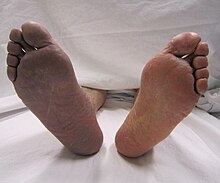| Acute limb ischaemia | |
|---|---|
| Other names | Acute limb ischemia |
 | |
| Acute embolism to the right femoral artery resulting in ischemia | |
| Symptoms | Cold, painful, pulseless limb that cannot move |
| Causes | Embolism, thrombosis |
| Treatment | Thrombectomy, embolectomy, thrombolysis |
| Medication | Thrombolytic drugs |
Acute limb ischaemia (ALI) occurs when there is a sudden lack of blood flow to a limb,[1] within 14 days of symptoms onset.[2] It is different from another condition which is more chronic (more than 14 days)[3] called critical limb ischemia (CLD). CLD is the end stage of peripheral vascular disease where there is still some collateral circulation (alternate circulation pathways} that bring some blood (but inadequate) to the distal parts of the limbs.[2] While limbs in both acute and chronic limb ischemia may be pulseless, a chronically ischemic limb is typically warm and pink due to a well-developed collateral artery network and does not need emergency intervention to avoid limb loss.[4]
Acute limb ischaemia is caused by embolism or thrombosis, or rarely by dissection or trauma.[5] Thrombosis is usually caused by peripheral vascular disease (atherosclerotic disease that leads to blood vessel blockage), while an embolism is usually of cardiac origin.[6] In the United States, ALI is estimated to occur in 14 out of every 100,000 people per year.[7] With proper surgical care, acute limb ischaemia is a highly treatable condition; however, delayed treatment (beyond 6 to 12 hours) can result in permanent disability, amputation, and/or death.
The New Latin term ischaemia as written, is a British version of the word ischemia, and stems from the Greek terms ischein 'to hold'; and haima 'blood'.[8] In this sense, ischaemia refers to the inhibition of blood flow to/through the limb.
- ^ Walker T. Gregory (2009). "Acute Limb Ischemia". Techniques in Vascular and Interventional Radiology. 12 (2): 117–129. doi:10.1053/j.tvir.2009.08.005. PMID 19853229.
- ^ a b Cite error: The named reference
pmid31416204was invoked but never defined (see the help page). - ^ Fabiani I, Calogero E, Pugliese NR, Di Stefano R, Nicastro I, Buttitta F, Nuti M, Violo C, Giannini D, Morgantini A, Conte L, Barletta V, Berchiolli R, Adami D, Ferrari M, Di Bello V (July 2018). "Critical Limb Ischemia: A Practical Up-To-Date Review". Angiology. 69 (6): 465–474. doi:10.1177/0003319717739387. PMID 29161885. S2CID 22281024.
- ^ Farber, A (12 July 2018). "Chronic Limb-Threatening Ischemia". The New England Journal of Medicine. 379 (2): 171–180. doi:10.1056/NEJMcp1709326. PMID 29996085. S2CID 51623293.
- ^ Creager, Mark A.; Kaufman, John A.; Conte, Michael S. (2012). "Acute Limb Ischemia". New England Journal of Medicine. 366 (23): 2198–2206. doi:10.1056/NEJMcp1006054. PMID 22670905.
- ^ Klonaris, C; Georgopoulos, S; Katsargyris, A; Tsekouras, N; Bakoyiannis, C; Giannopoulos, A; Bastounis, E (March 2007). "Changing patterns in the etiology of acute lower limb ischemia". International Angiology. 26 (1): 49–52. PMID 17353888.
- ^ Dormandy J, Heeck L, Vig S (June 1999). "Acute limb ischemia". Semin Vasc Surg. 12 (2): 148–53. PMID 10777242.
- ^ "Ischaemia." Merriam-Webster. Last modified 2012. http://www.merriam-webster.com/dictionary/ischemia?show=0&t=1334804041